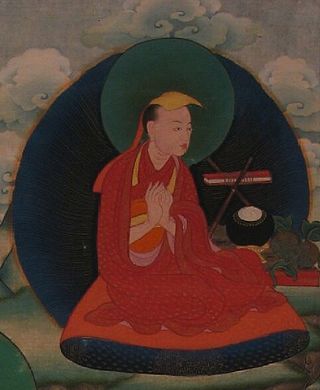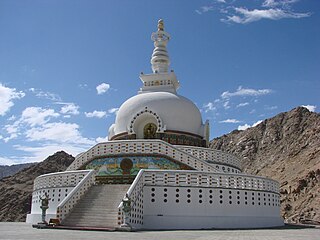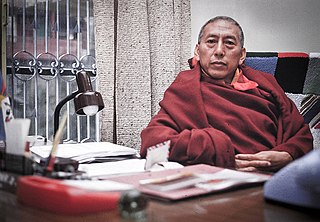A tulku is a distinctive and significant aspect of Tibetan Buddhism, embodying the concept of enlightened beings taking corporeal forms to continue the lineage of specific teachings. The term "tulku" has its origins in the Tibetan word "sprul sku", which originally referred to an emperor or ruler taking human form on Earth, signifying a divine incarnation. Over time, this term evolved within Tibetan Buddhism to denote the corporeal existence of highly accomplished Buddhist masters whose purpose is to ensure the preservation and transmission of a particular lineage.

The Ganden Tripa, also spelled Gaden Tripa, is the title of the spiritual leader of the Gelug school of Tibetan Buddhism, the school that controlled central Tibet from the mid-17th century until the 1950s. The 103rd Ganden Tripa, Jetsun Lobsang Tenzin, died in office on 21 April 2017. Currently, Jangtse Choejey Kyabje Jetsun Lobsang Tenzin Palsangpo is the 104th Ganden Tripa.

A Peace Pagoda is a Buddhist stupa: a monument to inspire peace, designed to provide a focus for people of all races and creeds, and to help unite them in their search for world peace. Most, though not all, peace pagodas built since World War II have been built under the guidance of Nichidatsu Fujii (1885–1985), a Buddhist monk from Japan and founder of the Nipponzan-Myōhōji Buddhist Order. Fujii was greatly inspired by his meeting with Mahatma Gandhi in 1931 and decided to devote his life to promoting non-violence. In 1947, he began constructing Peace Pagodas as shrines to world peace. The first was inaugurated at Kumamoto in 1954.

Diamond Way Buddhism is a lay organization within the Karma Kagyu school of Tibetan Buddhism. The first Diamond Way Buddhist center was founded in 1972 by Hannah Nydahl and Ole Nydahl in Copenhagen under the guidance of Rangjung Rigpe Dorje, 16th Karmapa. Today there are approximately 650 centers worldwide, directed by Ole Nydahl under the guidance of Trinley Thaye Dorje, one of two claimants to the title of the 17th Karmapa. Buddhist teachers such as Sherab Gyaltsen Rinpoche, Lama Jigme Rinpoche and Nedo Kuchung Rinpoche visit Diamond Way Buddhism centers and large meditation courses.

Kyabje Dudjom Rinpoche Jigdral Yeshe Dorje was known simply as Dudjom Rinpoche. He is considered by many Tibetan Buddhists to be from an important Tulku lineage of Terton Dudul Dorje (1615-1672), and was recognized as the incarnation of Terton Dudjom Lingpa (1835-1904), a renowned treasure revealer. He was a direct incarnation of both Padmasambhava and Dudjom Lingpa. He was a Nyingma Householder, a yogi, and a Vajrayana and Dzogchen master. According to his secretary Khenpo Tsewang Dongyal and many others, he was revered as "His Holiness" (Kyabje) and as a "Master of Masters".

Lobsang Tenzin, better known by the titles Professor Venerable Samdhong Rinpoche and to Tibetans as the 5th Samdhong Rinpoche, is a Tibetan Buddhist monk and politician who served as the Prime Minister of the cabinet of the Central Tibetan Administration, the Tibetan government-in-exile based in Dharamshala, India.

Although there was regular contact between practising Buddhists and Europeans in antiquity the former had little direct impact. In the latter half of the 19th century, Buddhism came to the attention of Western intellectuals and during the course of the following century the number of adherents has grown. There are now between 1 and 4 million Buddhists in Europe, the majority in Italy, Germany, Hungary, France and the United Kingdom.
Namgyal Rinpoche, Karma Tenzin Dorje (1931–2003), born Leslie George Dawson in Toronto, Canada, was a Tibetan Buddhist lama in the Karma Kagyu tradition.
Khunu Lama Tenzin Gyaltsen, 1894–1977, known also as Negi Lama Tenzin Gyaltsen, Tenzin Gyaltsen, and various other names like Kunu Rinpoche, Kunu Lama and Negi Lama, was born in 1894 in the village of Sunam which lies in the Kinnaur district of India in the western Himalayas. He passed away at the age of 82 at Shashur Monastery in the Lahaul and Spiti district of Himachel Pradesh on February 23, 1977, while teaching the final page of Gampopa's Jewel Ornament of Liberation. Khunu Rinpoche was not officially recognized as a tulku, nor was he an ordained Buddhist monk, but a layman who had taken lay practitioner's vows before becoming a Tibetan Buddhist master.
In Buddhism, a Kalachakra stupa is a stupa whose symbolism is not connected to events in the Buddha's life, but instead to the symbolism of the Kalachakra Tantra, created to protect against negative energies. It is the rarest kind of stupa.

Shanti Stupa is a Buddhist white-domed Stupa (chorten) on a hilltop in Chanspa, Leh district, Ladakh, in north India. It was built in 1991 by Japanese Buddhist Bhikshu, Gyomyo Nakamura. The Shanti Stupa holds the relics of the Buddha at its base, enshrined by the 14th Dalai Lama. The Stupa has become a tourist attraction not only due to its religious significance but also due to its location which provides panoramic views of the surrounding landscape.
There is a small Mongolian community in India, comprising mostly Buddhist monks and scholars as well as international students from Mongolia.

Tenzin is a Tibetan given name, meaning "the holder of Buddha Dharma". Tenzin can alternatively be spelled as Tenzing and Stanzin as well. Stanzin is generally used by the Ladakhi people, since Ladakhi language retains many archaic forms that have been lost in other modern Tibetan languages. For example, in Standard Written Tibetan, 'Tenzin' is spelled as "bstan'zin"; however, when it is spoken, both the 'b' and the 's' are silent and 'an' becomes 'en' in Standard Lhasa Tibetan.

The three poisons in the Mahayana tradition or the three unwholesome roots, in the Theravada tradition are a Buddhist term that refers to the three root kleshas that lead to all negative states. These three states are delusion, also known as ignorance; greed or sensual attachment; and hatred or aversion. These three poisons are considered to be three afflictions or character flaws that are innate in beings and the root of craving, and so causing suffering, pain or unsatisfactoriness and rebirth.

The Mind & Life Institute is a US-registered, not-for-profit 501(c)(3) organization founded in 1991 to establish the field of contemplative sciences. Based in Charlottesville, Va., the institute “brings science and contemplative wisdom together to better understand the mind and create positive change in the world." Over three decades, Mind & Life has played a key role in the mindfulness meditation movement by funding research projects and think tanks, and by convening conferences and dialogues with the Dalai Lama. Since 2020, Mind & Life's grant-making, events, and digital programs have sought to nurture personal wellbeing, build more compassionate communities, and strengthen the human–earth connection.

Buddha Smriti Park also known as Buddha Memorial Park is an urban park located on Frazer Road near Patna Junction in Patna, India. This park has been designed by Vikram Lall and developed by the Bihar Government to commemorate the 2554th birth anniversary of the Buddha. This park was inaugurated by the 14th Dalai Lama.

R. Adam Engle is an American social entrepreneur who initiated and developed the Mind and Life Dialogues between the 14th Dalai Lama of Tibet and panels of prominent scientists in the 1980s. Over the 22 years of his subsequent tenure as chief executive of the Mind and Life Institute, which he co-founded in 1990, his work contributed significantly to the establishment of contemplative science as a new field of research.

Bhikshu Gyomyo Nakamura is a Japanese Buddhist monk, fairytale writer and musician.

Shanti Stupa is a Buddhist monument in Delhi, India, intended as "a symbol of universal brotherhood and peace." It is one of several Peace Pagodas in the world. Started by the Nipponzan-Myōhōji-Daisanga religious order of Buddhism, it was inaugurated by the Dalai Lama on 4 November 2007.















